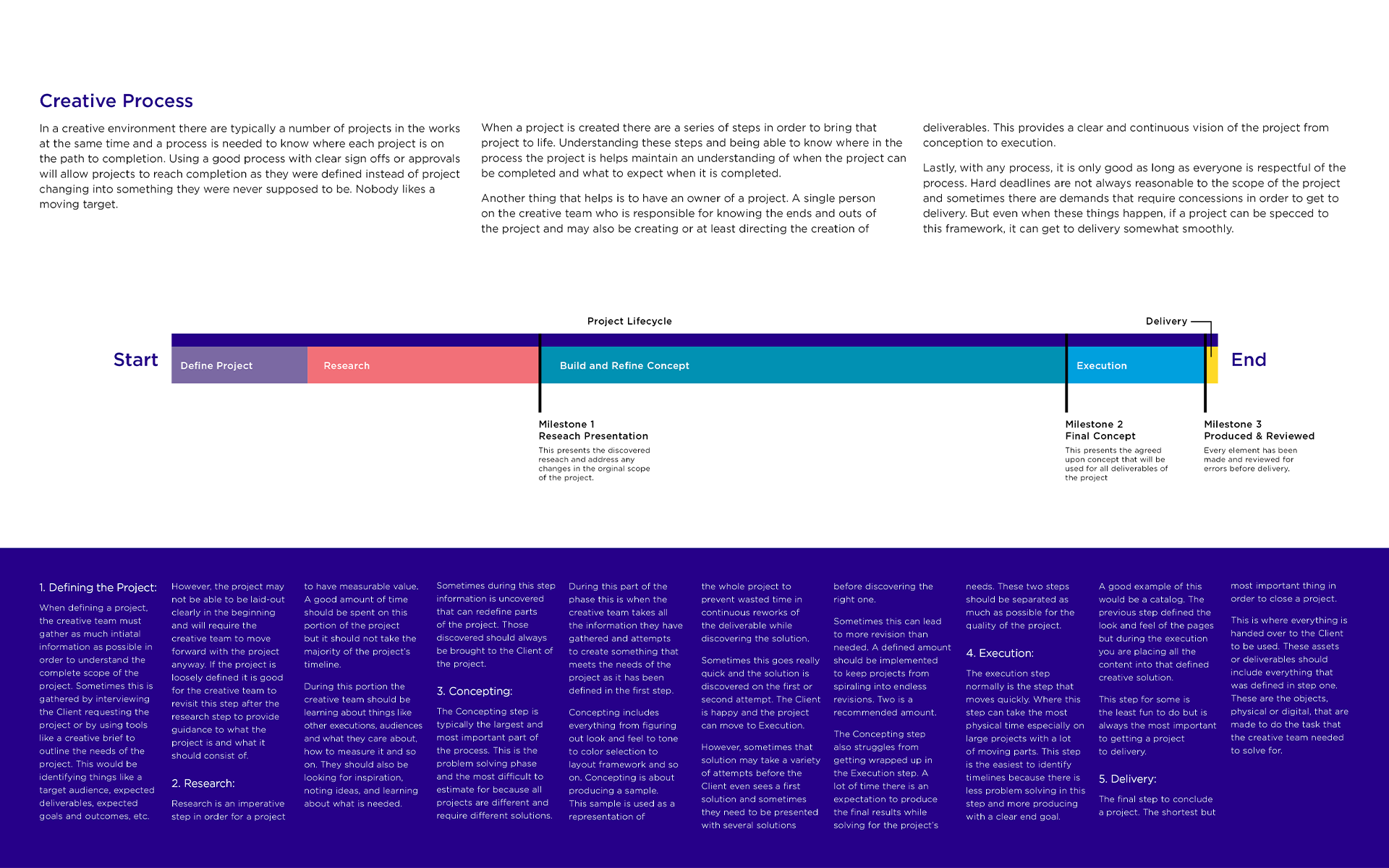Creative Process Infographic
After having many conversations on setting up processes to complete creative projects. I was tasked with outlining the steps of a project and the steps required to make it through it. I landed on a explanation that was an overview of all project and the step that should be taken to complete a project successfully.
There are five main steps to any project and doing them in order provides the best chance for a team to succeed. Those steps are Defining the Project, Research, Concepting, Execution, and Delivery. Without these steps project get messy and confusing for everyone involved.
Deliverables: Shareable PDF
Tools: InDesign


Creative Process
In a creative environment there are typically a number of projects in the works at the same time and a process is needed to know where each project is on the path to completion. Using a good process with clear sign offs or approvals will allow projects to reach completion as they were defined instead of project changing into something they were never supposed to be. Nobody likes a moving target.
When a project is created there are a series of steps in order to bring that project to life. Understanding these steps and being able to know where in the process the project is helps maintain an understanding of when the project can be completed and what to expect when it is completed.
Another thing that helps is to have an owner of a project. A single person on the creative team who is responsible for knowing the ends and outs of the project and may also be creating or at least directing the creation of deliverables. This provides a clear and continuous vision of the project from conception to execution.
Lastly, with any process, it is only good as long as everyone is respectful of the process. Hard deadlines are not always reasonable to the scope of the project and sometimes there are demands that require concessions in order to get to delivery. But even when these things happen, if a project can be specced to this framework, it can get to delivery somewhat smoothly.
Defining the Project:
When defining a project, the creative team must gather as much intiatal information as possible in order to understand the complete scope of the project. Sometimes this is gathered by interviewing the Client requesting the project or by using tools like a creative brief to outline the needs of the project. This would be identifying things like a target audience, expected deliverables, expected goals and outcomes, etc.
However, the project may not be able to be laid-out clearly in the beginning and will require the creative team to move forward with the project anyway. If the project is loosely defined it is good for the creative team to revisit this step after the research step to provide guidance to what the project is and what it should consist of.
Research:
Research is an imperative step in order for a project to have measurable value. A good amount of time should be spent on this portion of the project but it should not take the majority of the project’s timeline.
During this portion the creative team should be learning about things like other executions, audiences and what they care about, how to measure it and so on. They should also be looking for inspiration, noting ideas, and learning about what is needed.
Sometimes during this step information is uncovered that can redefine parts of the project. Those discovered should always be brought to the Client of the project.
Concepting:
The Concepting step is typically the largest and most important part of the process. This is the problem solving phase and the most difficult to estimate for because all projects are different and require different solutions.
During this part of the phase this is when the creative team takes all the information they have gathered and attempts to create something that meets the needs of the project as it has been defined in the first step.
Concepting includes everything from figuring out look and feel to tone to color selection to layout framework and so on. Concepting is about producing a sample. This sample is used as a representation of the whole project to prevent wasted time in continuous reworks of the deliverable while discovering the solution.
Sometimes this goes really quick and the solution is discovered on the first or second attempt. The Client is happy and the project can move to Execution.
However, sometimes that solution may take a variety of attempts before the Client even sees a first solution and sometimes they need to be presented with several solutions before discovering the right one.
Sometimes this can lead to more revision than needed. A defined amount should be implemented to keep projects from spiraling into endless revisions. Two is a recommended amount.
The Concepting step also struggles from getting wrapped up in the Execution step. A lot of time there is an expectation to produce the final results while solving for the project’s needs. These two steps should be separated as much as possible for the quality of the project.
Execution:
The execution step normally is the step that moves quickly. Where this step can take the most physical time especially on large projects with a lot of moving parts. This step is the easiest to identify timelines because there is less problem solving in this step and more producing with a clear end goal.
A good example of this would be a catalog. The previous step defined the look and feel of the pages but during the execution you are placing all the content into that defined creative solution.
This step for some is the least fun to do but is always the most important to getting a project to delivery.
Delivery:
The final step to conclude a project. The shortest but most important thing in order to close a project.
This is where everything is handed over to the Client to be used. These assets or deliverables should include everything that was defined in step one. These are the objects, physical or digital, that are made to do the task that the creative team needed to solve for.